University Finance Report: Analysis of Investment Property Rules
VerifiedAdded on 2022/12/26
|12
|2198
|93
Report
AI Summary
This report analyzes the framework of AASB 140 for investment property, focusing on the accounting policies and valuation methods used by entities. The report examines the application of both the fair value model and the cost model in determining investment property values, as well as the impact of the retail sector changes on the financial statements. It also discusses the economic significance of these changes. The report highlights the importance of transparency in financial reporting and the need for companies to adhere to AASB rules for property valuation. The report concludes that the company's performance requires improvement, and that the retail sector's performance significantly affects the economy and the company's financial condition. The analysis includes the impact of the retail sector's performance on the company's financial statements and the potential economic consequences of changes in the retail industry, emphasizing the importance of effective financial management and compliance with accounting standards.

Running head: ANALYSIS OF THE INVESTMENT PROPERTY RULES
Analysis of the Investment Property Rules
Name of the Student:
Name of the University:
Author’s Note
Analysis of the Investment Property Rules
Name of the Student:
Name of the University:
Author’s Note
Paraphrase This Document
Need a fresh take? Get an instant paraphrase of this document with our AI Paraphraser
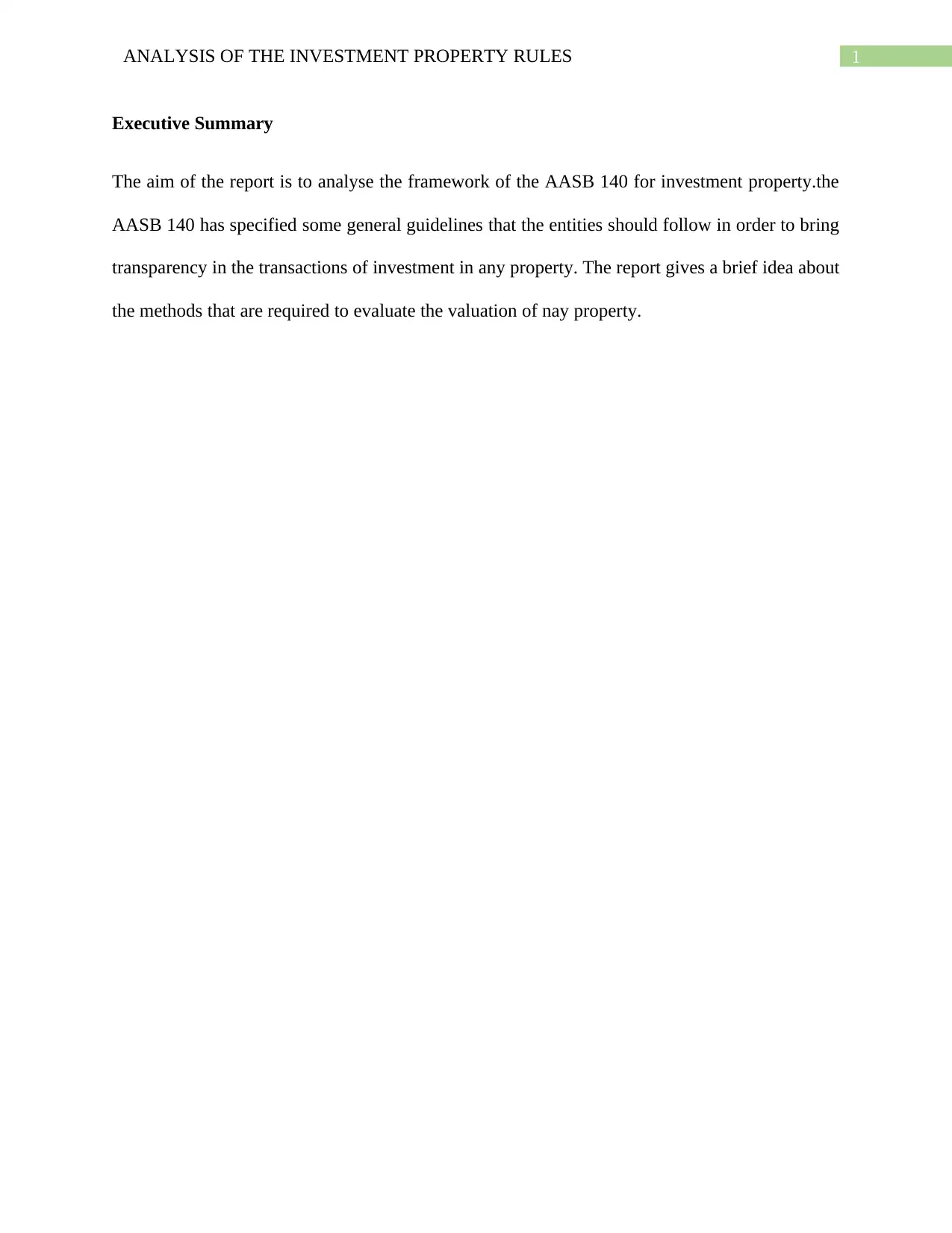
1ANALYSIS OF THE INVESTMENT PROPERTY RULES
Executive Summary
The aim of the report is to analyse the framework of the AASB 140 for investment property.the
AASB 140 has specified some general guidelines that the entities should follow in order to bring
transparency in the transactions of investment in any property. The report gives a brief idea about
the methods that are required to evaluate the valuation of nay property.
Executive Summary
The aim of the report is to analyse the framework of the AASB 140 for investment property.the
AASB 140 has specified some general guidelines that the entities should follow in order to bring
transparency in the transactions of investment in any property. The report gives a brief idea about
the methods that are required to evaluate the valuation of nay property.

2ANALYSIS OF THE INVESTMENT PROPERTY RULES
Table of Contents
Introduction......................................................................................................................................3
Discussion........................................................................................................................................3
Conclusion.......................................................................................................................................7
Reference.........................................................................................................................................8
Table of Contents
Introduction......................................................................................................................................3
Discussion........................................................................................................................................3
Conclusion.......................................................................................................................................7
Reference.........................................................................................................................................8
⊘ This is a preview!⊘
Do you want full access?
Subscribe today to unlock all pages.

Trusted by 1+ million students worldwide

3ANALYSIS OF THE INVESTMENT PROPERTY RULES
Introduction
The AASB set the rules that an entity should follow before investing in any property. The
rule sets the guideline, which is mandatory for every entity that deals in investment property. The
financial statements of the entity should be made according to the rules of the AASB and the
company should made all necessary disclosure to ensure the transparency in recording the
accounting entries for investment property.
Discussion
(A) The accounting policies of SCP and the regulations that dictate the accounting policy of SCP
In accordance with the AASB 3, the SCP group prepare the financial statements the
shopping Centre management trust has been considered as the parent company for preparation of
the consolidated financial report.
The SCP group while recording the accounting entries adopts the following methods
Historical cost convention
The financial statements are made on the basis of the historical cost except for recording
certain non-current assets and financial instruments that are measured in the fair value.
Going concern basis
The consolidated financial statements are prepared on the going concern basis.in the note
to the financial report the directors has stated that the group and the retail trust are in a net
current assets deficiency position due to minimal balance in cash and cash equivalent.
Rounding off
Introduction
The AASB set the rules that an entity should follow before investing in any property. The
rule sets the guideline, which is mandatory for every entity that deals in investment property. The
financial statements of the entity should be made according to the rules of the AASB and the
company should made all necessary disclosure to ensure the transparency in recording the
accounting entries for investment property.
Discussion
(A) The accounting policies of SCP and the regulations that dictate the accounting policy of SCP
In accordance with the AASB 3, the SCP group prepare the financial statements the
shopping Centre management trust has been considered as the parent company for preparation of
the consolidated financial report.
The SCP group while recording the accounting entries adopts the following methods
Historical cost convention
The financial statements are made on the basis of the historical cost except for recording
certain non-current assets and financial instruments that are measured in the fair value.
Going concern basis
The consolidated financial statements are prepared on the going concern basis.in the note
to the financial report the directors has stated that the group and the retail trust are in a net
current assets deficiency position due to minimal balance in cash and cash equivalent.
Rounding off
Paraphrase This Document
Need a fresh take? Get an instant paraphrase of this document with our AI Paraphraser

4ANALYSIS OF THE INVESTMENT PROPERTY RULES
As per the accounting, standards all the amounts in the financial statements are rounded
off to the nearest hundred thousand dollars.
Compliances
The financial reports are prepared by complying with the regulations of the AASB. The
financial statements are in accordance to the rules that are made for the preparation of the
financial statements of a for profit making entity.
New and amended accounting standards.
The group has applied amendments to AASB issued by the board of the accounting
standards of Australia. The following AASBs adopted by the group:
AASB 9 Financial instruments:
The amended accounting standard is for the accounting treatment of the financial
instruments.as per the standard the recognition and measurement of the instruments is not
expected to change apart from the investment classified as available for sale will now be treated
as investment through other comprehensive income if and when this investment is derecognized.
the cumulative gain or loss w bill not be recorded in the profit and loss account and it will be
recorded as other comprehensive gain or loss (Crosby & Henneberry 2016).
AASB 15 revenue from contract with customers:
The AASB 15 has five step model to determine when and how much revenue to be
recognized. The standard set the rule that either a full retrospective or approach for the adoption.
As per the accounting, standards all the amounts in the financial statements are rounded
off to the nearest hundred thousand dollars.
Compliances
The financial reports are prepared by complying with the regulations of the AASB. The
financial statements are in accordance to the rules that are made for the preparation of the
financial statements of a for profit making entity.
New and amended accounting standards.
The group has applied amendments to AASB issued by the board of the accounting
standards of Australia. The following AASBs adopted by the group:
AASB 9 Financial instruments:
The amended accounting standard is for the accounting treatment of the financial
instruments.as per the standard the recognition and measurement of the instruments is not
expected to change apart from the investment classified as available for sale will now be treated
as investment through other comprehensive income if and when this investment is derecognized.
the cumulative gain or loss w bill not be recorded in the profit and loss account and it will be
recorded as other comprehensive gain or loss (Crosby & Henneberry 2016).
AASB 15 revenue from contract with customers:
The AASB 15 has five step model to determine when and how much revenue to be
recognized. The standard set the rule that either a full retrospective or approach for the adoption.
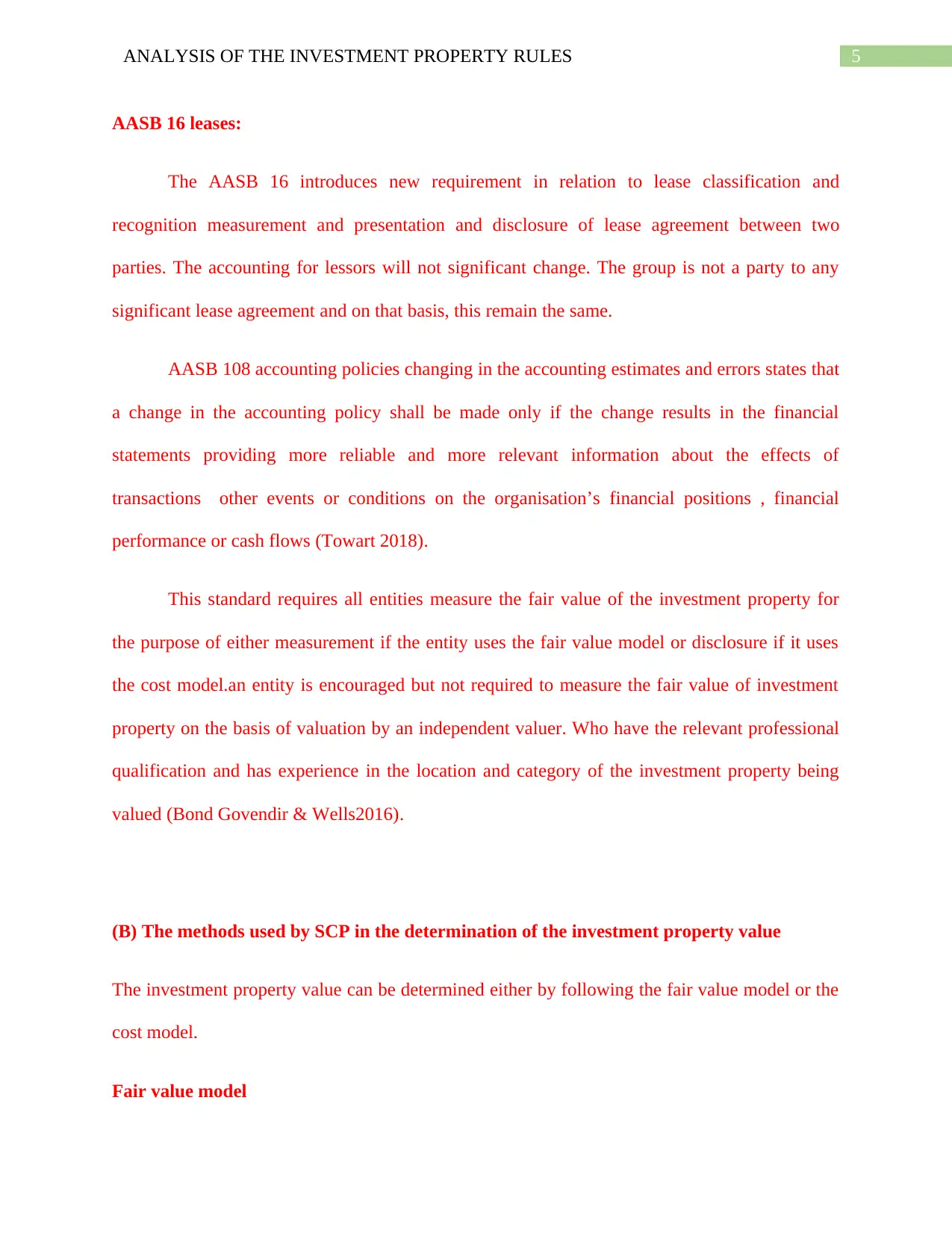
5ANALYSIS OF THE INVESTMENT PROPERTY RULES
AASB 16 leases:
The AASB 16 introduces new requirement in relation to lease classification and
recognition measurement and presentation and disclosure of lease agreement between two
parties. The accounting for lessors will not significant change. The group is not a party to any
significant lease agreement and on that basis, this remain the same.
AASB 108 accounting policies changing in the accounting estimates and errors states that
a change in the accounting policy shall be made only if the change results in the financial
statements providing more reliable and more relevant information about the effects of
transactions other events or conditions on the organisation’s financial positions , financial
performance or cash flows (Towart 2018).
This standard requires all entities measure the fair value of the investment property for
the purpose of either measurement if the entity uses the fair value model or disclosure if it uses
the cost model.an entity is encouraged but not required to measure the fair value of investment
property on the basis of valuation by an independent valuer. Who have the relevant professional
qualification and has experience in the location and category of the investment property being
valued (Bond Govendir & Wells2016).
(B) The methods used by SCP in the determination of the investment property value
The investment property value can be determined either by following the fair value model or the
cost model.
Fair value model
AASB 16 leases:
The AASB 16 introduces new requirement in relation to lease classification and
recognition measurement and presentation and disclosure of lease agreement between two
parties. The accounting for lessors will not significant change. The group is not a party to any
significant lease agreement and on that basis, this remain the same.
AASB 108 accounting policies changing in the accounting estimates and errors states that
a change in the accounting policy shall be made only if the change results in the financial
statements providing more reliable and more relevant information about the effects of
transactions other events or conditions on the organisation’s financial positions , financial
performance or cash flows (Towart 2018).
This standard requires all entities measure the fair value of the investment property for
the purpose of either measurement if the entity uses the fair value model or disclosure if it uses
the cost model.an entity is encouraged but not required to measure the fair value of investment
property on the basis of valuation by an independent valuer. Who have the relevant professional
qualification and has experience in the location and category of the investment property being
valued (Bond Govendir & Wells2016).
(B) The methods used by SCP in the determination of the investment property value
The investment property value can be determined either by following the fair value model or the
cost model.
Fair value model
⊘ This is a preview!⊘
Do you want full access?
Subscribe today to unlock all pages.

Trusted by 1+ million students worldwide

6ANALYSIS OF THE INVESTMENT PROPERTY RULES
When a property interest kept by a lessee under an operating lease it is classified as an
investment property and in that case the fair value model will be applicable for that property.
The fair value of an asset is reliably measurable if the variability in the range of
reasonable fair value measurement is not significant for that asset.
The profit or loss that arise from the change in the value of investment shall be recorded
in the profit and loss statement for the period in which it arise (Raff & Schmitt 2016).
While calculating the fair value of the investment property in accordance with AASB 13
the entity shall make sure that the fair value reflects the rental income from current lease and
other assumptions that market participants would use when pricing the investment property
under the current market price (Daams Sijtsma & van der Vlist 2016).
If the lease is negotiated at the market rate the fair value of an interest in the leased
property at acquisition net of all expected lease payment should be zero. This fair value does not
change regardless of whether for accounting purpose a leased asset or liability is recognised at
the fair value or at the present value of minimum leasae payment in accordance with the rule of
AASB 117. Thus measuring a leased asset from the cost to fair value ar at the present value of
minimum lease payment should not give rise to any profit or loss unless the fair value is
measured at different times .this could happen when an election to apply the fair value model is
made after initial recognition (Chung et al 2017).
In exceptional cases, there is clear evidence when an entity first acquires an investment
property that the variability in the range of reasonable fair value measurement will be so high
and the probability of the various results will become so difficult to assess that the usefulness of
a single measure of fair value is neglected (Palea 2015).
When a property interest kept by a lessee under an operating lease it is classified as an
investment property and in that case the fair value model will be applicable for that property.
The fair value of an asset is reliably measurable if the variability in the range of
reasonable fair value measurement is not significant for that asset.
The profit or loss that arise from the change in the value of investment shall be recorded
in the profit and loss statement for the period in which it arise (Raff & Schmitt 2016).
While calculating the fair value of the investment property in accordance with AASB 13
the entity shall make sure that the fair value reflects the rental income from current lease and
other assumptions that market participants would use when pricing the investment property
under the current market price (Daams Sijtsma & van der Vlist 2016).
If the lease is negotiated at the market rate the fair value of an interest in the leased
property at acquisition net of all expected lease payment should be zero. This fair value does not
change regardless of whether for accounting purpose a leased asset or liability is recognised at
the fair value or at the present value of minimum leasae payment in accordance with the rule of
AASB 117. Thus measuring a leased asset from the cost to fair value ar at the present value of
minimum lease payment should not give rise to any profit or loss unless the fair value is
measured at different times .this could happen when an election to apply the fair value model is
made after initial recognition (Chung et al 2017).
In exceptional cases, there is clear evidence when an entity first acquires an investment
property that the variability in the range of reasonable fair value measurement will be so high
and the probability of the various results will become so difficult to assess that the usefulness of
a single measure of fair value is neglected (Palea 2015).
Paraphrase This Document
Need a fresh take? Get an instant paraphrase of this document with our AI Paraphraser
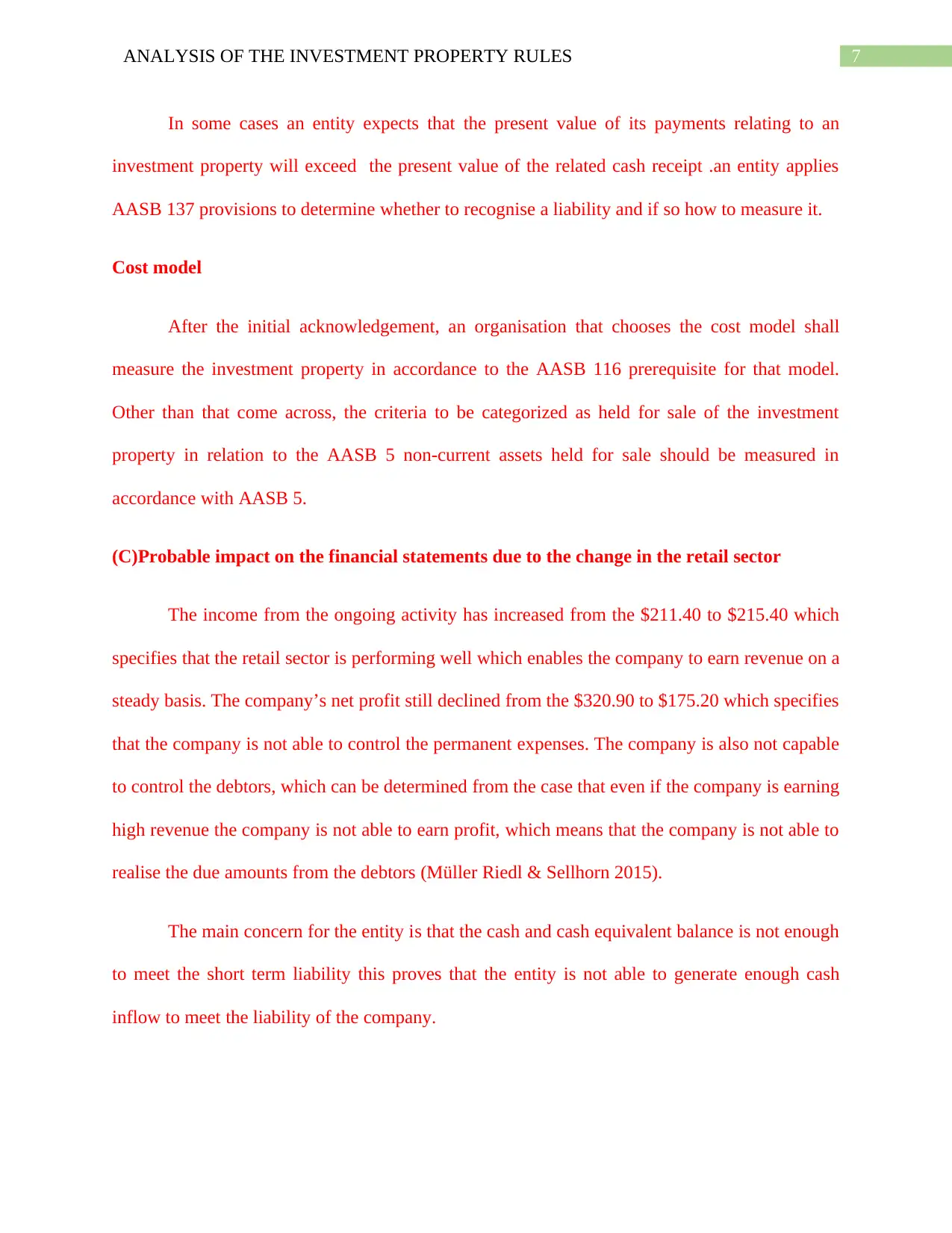
7ANALYSIS OF THE INVESTMENT PROPERTY RULES
In some cases an entity expects that the present value of its payments relating to an
investment property will exceed the present value of the related cash receipt .an entity applies
AASB 137 provisions to determine whether to recognise a liability and if so how to measure it.
Cost model
After the initial acknowledgement, an organisation that chooses the cost model shall
measure the investment property in accordance to the AASB 116 prerequisite for that model.
Other than that come across, the criteria to be categorized as held for sale of the investment
property in relation to the AASB 5 non-current assets held for sale should be measured in
accordance with AASB 5.
(C)Probable impact on the financial statements due to the change in the retail sector
The income from the ongoing activity has increased from the $211.40 to $215.40 which
specifies that the retail sector is performing well which enables the company to earn revenue on a
steady basis. The company’s net profit still declined from the $320.90 to $175.20 which specifies
that the company is not able to control the permanent expenses. The company is also not capable
to control the debtors, which can be determined from the case that even if the company is earning
high revenue the company is not able to earn profit, which means that the company is not able to
realise the due amounts from the debtors (Müller Riedl & Sellhorn 2015).
The main concern for the entity is that the cash and cash equivalent balance is not enough
to meet the short term liability this proves that the entity is not able to generate enough cash
inflow to meet the liability of the company.
In some cases an entity expects that the present value of its payments relating to an
investment property will exceed the present value of the related cash receipt .an entity applies
AASB 137 provisions to determine whether to recognise a liability and if so how to measure it.
Cost model
After the initial acknowledgement, an organisation that chooses the cost model shall
measure the investment property in accordance to the AASB 116 prerequisite for that model.
Other than that come across, the criteria to be categorized as held for sale of the investment
property in relation to the AASB 5 non-current assets held for sale should be measured in
accordance with AASB 5.
(C)Probable impact on the financial statements due to the change in the retail sector
The income from the ongoing activity has increased from the $211.40 to $215.40 which
specifies that the retail sector is performing well which enables the company to earn revenue on a
steady basis. The company’s net profit still declined from the $320.90 to $175.20 which specifies
that the company is not able to control the permanent expenses. The company is also not capable
to control the debtors, which can be determined from the case that even if the company is earning
high revenue the company is not able to earn profit, which means that the company is not able to
realise the due amounts from the debtors (Müller Riedl & Sellhorn 2015).
The main concern for the entity is that the cash and cash equivalent balance is not enough
to meet the short term liability this proves that the entity is not able to generate enough cash
inflow to meet the liability of the company.
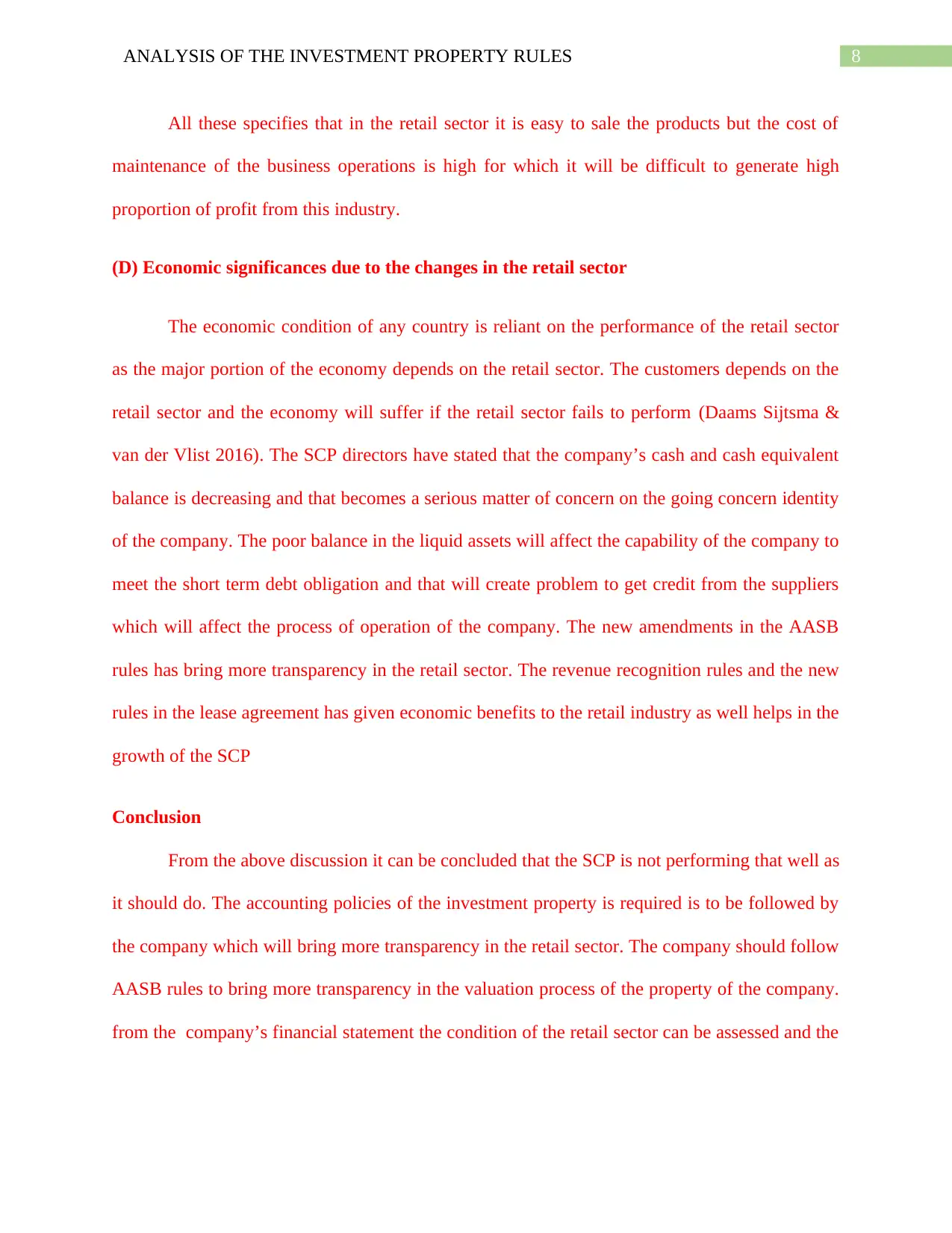
8ANALYSIS OF THE INVESTMENT PROPERTY RULES
All these specifies that in the retail sector it is easy to sale the products but the cost of
maintenance of the business operations is high for which it will be difficult to generate high
proportion of profit from this industry.
(D) Economic significances due to the changes in the retail sector
The economic condition of any country is reliant on the performance of the retail sector
as the major portion of the economy depends on the retail sector. The customers depends on the
retail sector and the economy will suffer if the retail sector fails to perform (Daams Sijtsma &
van der Vlist 2016). The SCP directors have stated that the company’s cash and cash equivalent
balance is decreasing and that becomes a serious matter of concern on the going concern identity
of the company. The poor balance in the liquid assets will affect the capability of the company to
meet the short term debt obligation and that will create problem to get credit from the suppliers
which will affect the process of operation of the company. The new amendments in the AASB
rules has bring more transparency in the retail sector. The revenue recognition rules and the new
rules in the lease agreement has given economic benefits to the retail industry as well helps in the
growth of the SCP
Conclusion
From the above discussion it can be concluded that the SCP is not performing that well as
it should do. The accounting policies of the investment property is required is to be followed by
the company which will bring more transparency in the retail sector. The company should follow
AASB rules to bring more transparency in the valuation process of the property of the company.
from the company’s financial statement the condition of the retail sector can be assessed and the
All these specifies that in the retail sector it is easy to sale the products but the cost of
maintenance of the business operations is high for which it will be difficult to generate high
proportion of profit from this industry.
(D) Economic significances due to the changes in the retail sector
The economic condition of any country is reliant on the performance of the retail sector
as the major portion of the economy depends on the retail sector. The customers depends on the
retail sector and the economy will suffer if the retail sector fails to perform (Daams Sijtsma &
van der Vlist 2016). The SCP directors have stated that the company’s cash and cash equivalent
balance is decreasing and that becomes a serious matter of concern on the going concern identity
of the company. The poor balance in the liquid assets will affect the capability of the company to
meet the short term debt obligation and that will create problem to get credit from the suppliers
which will affect the process of operation of the company. The new amendments in the AASB
rules has bring more transparency in the retail sector. The revenue recognition rules and the new
rules in the lease agreement has given economic benefits to the retail industry as well helps in the
growth of the SCP
Conclusion
From the above discussion it can be concluded that the SCP is not performing that well as
it should do. The accounting policies of the investment property is required is to be followed by
the company which will bring more transparency in the retail sector. The company should follow
AASB rules to bring more transparency in the valuation process of the property of the company.
from the company’s financial statement the condition of the retail sector can be assessed and the
⊘ This is a preview!⊘
Do you want full access?
Subscribe today to unlock all pages.

Trusted by 1+ million students worldwide
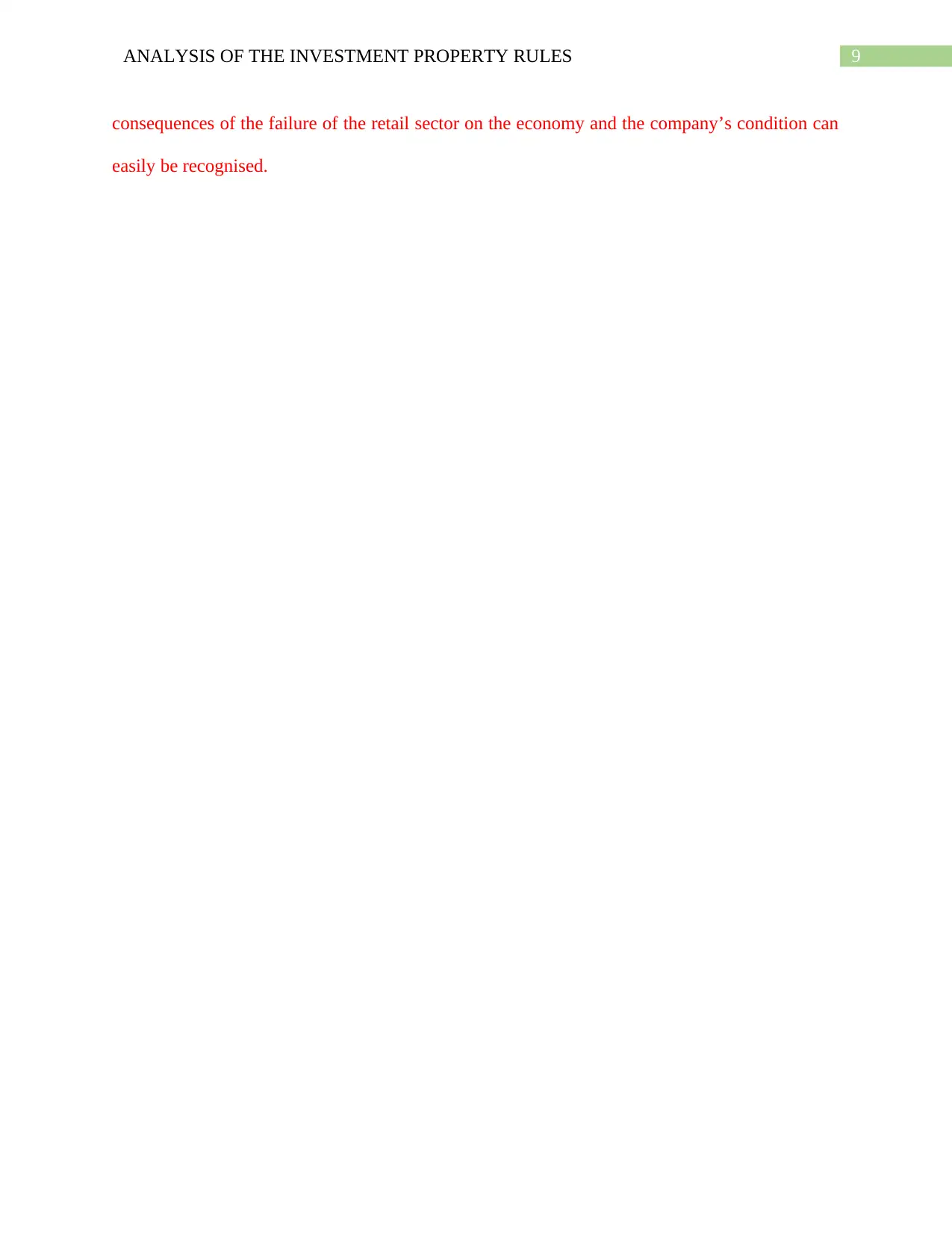
9ANALYSIS OF THE INVESTMENT PROPERTY RULES
consequences of the failure of the retail sector on the economy and the company’s condition can
easily be recognised.
consequences of the failure of the retail sector on the economy and the company’s condition can
easily be recognised.
Paraphrase This Document
Need a fresh take? Get an instant paraphrase of this document with our AI Paraphraser

10ANALYSIS OF THE INVESTMENT PROPERTY RULES
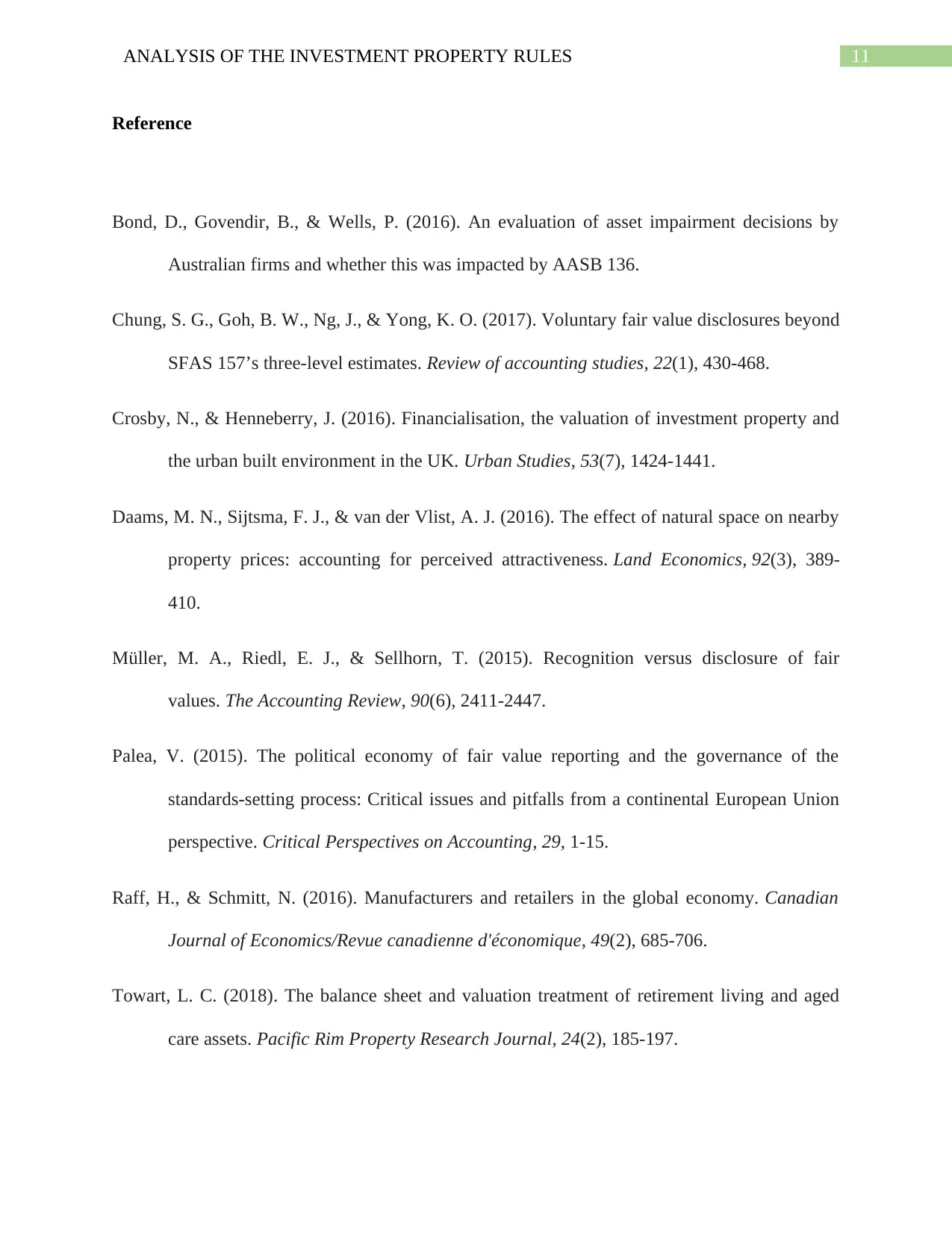
11ANALYSIS OF THE INVESTMENT PROPERTY RULES
Reference
Bond, D., Govendir, B., & Wells, P. (2016). An evaluation of asset impairment decisions by
Australian firms and whether this was impacted by AASB 136.
Chung, S. G., Goh, B. W., Ng, J., & Yong, K. O. (2017). Voluntary fair value disclosures beyond
SFAS 157’s three-level estimates. Review of accounting studies, 22(1), 430-468.
Crosby, N., & Henneberry, J. (2016). Financialisation, the valuation of investment property and
the urban built environment in the UK. Urban Studies, 53(7), 1424-1441.
Daams, M. N., Sijtsma, F. J., & van der Vlist, A. J. (2016). The effect of natural space on nearby
property prices: accounting for perceived attractiveness. Land Economics, 92(3), 389-
410.
Müller, M. A., Riedl, E. J., & Sellhorn, T. (2015). Recognition versus disclosure of fair
values. The Accounting Review, 90(6), 2411-2447.
Palea, V. (2015). The political economy of fair value reporting and the governance of the
standards-setting process: Critical issues and pitfalls from a continental European Union
perspective. Critical Perspectives on Accounting, 29, 1-15.
Raff, H., & Schmitt, N. (2016). Manufacturers and retailers in the global economy. Canadian
Journal of Economics/Revue canadienne d'économique, 49(2), 685-706.
Towart, L. C. (2018). The balance sheet and valuation treatment of retirement living and aged
care assets. Pacific Rim Property Research Journal, 24(2), 185-197.
Reference
Bond, D., Govendir, B., & Wells, P. (2016). An evaluation of asset impairment decisions by
Australian firms and whether this was impacted by AASB 136.
Chung, S. G., Goh, B. W., Ng, J., & Yong, K. O. (2017). Voluntary fair value disclosures beyond
SFAS 157’s three-level estimates. Review of accounting studies, 22(1), 430-468.
Crosby, N., & Henneberry, J. (2016). Financialisation, the valuation of investment property and
the urban built environment in the UK. Urban Studies, 53(7), 1424-1441.
Daams, M. N., Sijtsma, F. J., & van der Vlist, A. J. (2016). The effect of natural space on nearby
property prices: accounting for perceived attractiveness. Land Economics, 92(3), 389-
410.
Müller, M. A., Riedl, E. J., & Sellhorn, T. (2015). Recognition versus disclosure of fair
values. The Accounting Review, 90(6), 2411-2447.
Palea, V. (2015). The political economy of fair value reporting and the governance of the
standards-setting process: Critical issues and pitfalls from a continental European Union
perspective. Critical Perspectives on Accounting, 29, 1-15.
Raff, H., & Schmitt, N. (2016). Manufacturers and retailers in the global economy. Canadian
Journal of Economics/Revue canadienne d'économique, 49(2), 685-706.
Towart, L. C. (2018). The balance sheet and valuation treatment of retirement living and aged
care assets. Pacific Rim Property Research Journal, 24(2), 185-197.
⊘ This is a preview!⊘
Do you want full access?
Subscribe today to unlock all pages.

Trusted by 1+ million students worldwide
1 out of 12
Related Documents
Your All-in-One AI-Powered Toolkit for Academic Success.
+13062052269
info@desklib.com
Available 24*7 on WhatsApp / Email
![[object Object]](/_next/static/media/star-bottom.7253800d.svg)
Unlock your academic potential
Copyright © 2020–2025 A2Z Services. All Rights Reserved. Developed and managed by ZUCOL.





